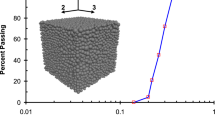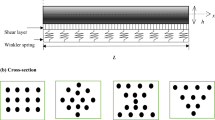Abstract
Hypervelocity impact (HVI) on carbon fiber reinforced plastics (CFRPs) is associated with extreme impulse response of material as well as complex characteristics of the composites. It is a challenging task to predict the physical process of CFRP-HVI problems accurately. We apply a GPU-accelerated smoothed particle hydrodynamics (SPH) method which incorporates the composite material model and the decoupled finite particle method to simulate the CFRP-HVI processes. The presented SPH model is validated by simulating the processes of aluminum spheres impacting metallic plates. The simulation results agree well with available experimental and numerical results, and the GPU parallelization technique significantly improves the simulation efficiency (350 times faster than an equivalent serial SPH model). With such computational accuracy and efficiency, the model is extended to simulate CFRP laminate impact problems, and a particle convergence analysis is performed. It is shown that the model can obtain convergent results when modeling each CFRP layer with three SPH particles in the thickness direction and correspondingly using about twenty million particles in total. The simulation can be completed within several hours, and the dominant mechanisms of the CFRP-HVI can be captured quantitatively. To further investigate the protective performance of CFRP structures, HVI on a well-known shielding structure Whipple bumper is investigated numerically. The dynamic response of the structure is well reproduced, and the results show that the CFRP pressure wall is more effective than the metallic one. These simulation results demonstrate that the presented SPH model can model the CFRP-HVI problems accurately and efficiently.


















Similar content being viewed by others
References
Johnson L (2013) Sky alert!: when satellites fail. Springer, New York
Ryan S, Schaefer F, Riedel W (2006) Numerical simulation of hypervelocity impact on CFRP/Al HC SP spacecraft structures causing penetration and fragment ejection. Int J Impact Eng 33(1/12):703–712
Francesconi A, Giacomuzzo C, Kibe S, Nagao Y, Higashide M (2012) Effects of high-speed impacts on CFRP plates for space applications. Adv Space Res 50(5):539–548
Tennyson RC, Lamontagne C (2000) Hypervelocity impact damage to composites. Compos A 31(8):785–794
Lamontagne CG, Manuelpillai GN, Kerr JH (2001) Projectile density, impact angle and energy effects on hypervelocity impact damage to carbon fibre/peek composites. Int J Impact Eng 26(1/10):381–398
Katz S, Grossman E, Gouzman I, Murat M, Wiesel E, Wagner HD (2008) Response of composite materials to hypervelocity impact. Int J Impact Eng 35(12):1606–1611
Hazell PJ, Cowie A, Kister G, Stennett C, Cooper GA (2009) Penetration of a woven CFRP laminate by a high velocity steel sphere impacting at velocities of up to 1875 m/s. Int J Impact Eng 36(9):1136–1142
Numata D, Ohtani K, Anyoji M, Takayama K, Togami K, Sun M (2008) HVI tests on CFRP laminates at low temperature. Int J Impact Eng 35(12):1695–1701
Higashide HM (2013) Ejecta size distribution resulting from hypervelocity impact of spherical projectiles on CFRP laminates. Procedia Eng
Hou ND, Zhao RX, Li J, Wang X, Li X, Cui H, Li YL (2022) Impact damage of composite laminates with high-speed waterjet. Int J Impact Eng 167:104276
Horner JK (2008) A comparison of ballistic limit with adaptive-mesh Eulerian hydrocode predictions of one- and two-plate aluminum shielding protection against millimeter-sized Fe-Ni space debris. Int J Impact Eng 35(12):1602–1605
Liu T, Li XG, Jia GH, Zhang XT (2015) Element fracture technique for hypervelocity impact simulation. Adv Space Res Off J Commit Space Res 55:2293–2304
Addessio FL, Carroll DE, Dukowicz JK, Harlow FH, Johnson JN (1986) CAVEAT: a computer code for fluid dynamics problems with large distortion and internal slip
Swegle JW, Attaway SW (1995) On the feasibility of using smoothed particle hydrodynamics for underwater explosion calculations. Comput Mech 17(3):151–168
Mehra V, Chaturvedi S (2006) High velocity impact of metal sphere on thin metallic plates: A comparative smooth particle hydrodynamics study. J Comput Phys 212(1):318–337
Zhou CE, Liu GR, Lou KY (2007) Three-dimensional penetration simulation using smoothed particle hydrodynamics. Int J Comput Methods 4(04):671–691
Medina DF, Chen JK (2000) Three-dimensional simulations of impact induced damage in composite structures using the parallelized SPH method. Compos A 31(8):853–860
White DM, Taylor EA, Richard A (2003) Numerical simulation and experimental charcterisation of direct hypervelocity impact on a spacecraft hybrid carbon fibre/Kevlar composite structure. Int J Impact Eng 29:779–790
Wicklein M, Ryan S, White DM, Clegg RA (2008) Hypervelocity impact on CFRP: testing, material modelling, and numerical simulation. Int J Impact Eng 35(12):1861–1869
Giannaros E, Kotzakolios A, Kostopoulos V, Campoli G (2018) Hypervelocity impact response of CFRP laminates using smoothed particle hydrodynamics method: implementation and validation. Int J Impact Eng 123(JAN.):56–69
Giannaros E, Kotzakolios A, Kostopoulos V, Sotiriadis G, Vignjevic R, Djordjevic N, Boccaccio M, Meo M (2021) Low- and high-fidelity modeling of sandwich-structured composite response to bird strike, as tools for a digital-twin-assisted damage diagnosis. Int J Impact Eng 160:104058
Hérault A, Bilotta G, Dalrymple RA (2010) SPH on GPU with CUDA. J Hydraul Res 48(sup1):74–79
Crespo AJC, Domínguez JM, Rogers BD, Gómez-Gesteira M, Longshaw S, Canelas R, Vacondio R, Barreiro A, García-Feal O (2015) DualSPHysics: open-source parallel CFD solver based on smoothed particle hydrodynamics (SPH). Comput Phys Commun 187:204–216
Peng C, Wang S, Wu W, Yu HS, Chen JY (2019) LOQUAT: an open-source GPU-accelerated SPH solver for geotechnical modeling. Acta Geotech 14(21):1269–1287
Chen JY, Feng DL, Deng SX, Peng C, Lien FS (2020) GPU-accelerated smoothed particle hydrodynamics modeling of jet formation and penetration capability of shaped charges. J Fluids Struct 99:103171
Zhang ZL, Liu MB (2017) Smoothed particle hydrodynamics with kernel gradient correction for modeling high velocity impact in two- and three-dimensional spaces. Eng Anal Bound Elem 83(OCT.):141–157
Feng DL, Liu MB, Li HQ, Liu GR (2013) Smoothed particle hydrodynamics modeling of linear shaped charge with jet formation and penetration effects. Comput Fluids 86:77–85
Chen JK, Beraun JE (2000) A generalized smoothed particle hydrodynamics method for nonlinear dynamic problems. Comput Methods Appl Mech Eng 190(1/2):225–239
Liu MB, Xie WP, Liu GR (2005) Modeling incompressible flows using a finite particle method. Appl Math Model 29(12):1252–1270
Zhang ZL, Liu MB (2018) A decoupled finite particle method for modeling incompressible flows with free surfaces. Appl Math Model 60(AUG.):606–633
Johnson GR, Cook WH (1983) A constitutive model and data for metals subjected to large strains, high strain rates and high temperatures. Eng Fract Mech 21:541–548
Chang FK, Chang KY (1987) A progressive damage model for laminated composites containing stress concentrations. J Compos Mater 21(9):834–855
Brewer JC, Lagace PA (1988) Quadratic stress criterion for initiation of delamination. J Compos Mater 22(12):1141–1155
Katayama M, Takeba A, Toda S, Kibe S (1999) Analysis of jet formation and penetration by conical shaped charge with the inhibitor. Int J Impact Eng 23(1):443–454
Kurosawa K, Nagaoka Y, Senshu H, Wada K, Hasegawa S, Sugita S, Matsui T (2015) Dynamics of hypervelocity jetting during oblique impacts of spherical projectiles investigated via ultrafast imaging: ultrafast imaging of impact jetting. J Geophys Res Planets 120(7):1237–1251
Wendland H (1995) Piecewise polynomial, positive definite and compactly supported radial functions of minimal degree. Adv Comput Math 4(1):389–396
Monaghan JJ (2000) SPH without a tensile instability. J Comput Phys 159(2):290–311
Hiermaier S, Knke D, Stilp AJ, Thoma K (1997) Computational simulation of the hypervelocity impact of Al-spheres on thin plates of different materials. Int J Impact Eng 20(1):363–374
Chen JY, Lien FS, Peng C, Yee E (2020) GPU-accelerated smoothed particle hydrodynamics modeling of granular flow. Powder Technol 359:94–106
Huang XG, Yin C, Huang J, Wen XZ, Zhao ZM, Wu JY, Liu S (2016) Hypervelocity impact of TiB2-based composites as front bumpers for space shield applications. Mater Des 97:473–482
Acknowledgements
Dianlei Feng wants to thank the Fundamental Research Funds for the Central Universities in China for the financial support. This work is also supported by the Natural Science Foundation of Jiangsu province of China (No. BK20210319) and by the opening project (No. KFJJ22-12M) of the State Key Laboratory of Explosion Science and Technology at the Beijing Institute of Technology.
Author information
Authors and Affiliations
Corresponding authors
Additional information
Publisher's Note
Springer Nature remains neutral with regard to jurisdictional claims in published maps and institutional affiliations.
Rights and permissions
Springer Nature or its licensor (e.g. a society or other partner) holds exclusive rights to this article under a publishing agreement with the author(s) or other rightsholder(s); author self-archiving of the accepted manuscript version of this article is solely governed by the terms of such publishing agreement and applicable law.
About this article
Cite this article
Lu, Y., Chen, J., Feng, D. et al. Numerical modeling of hypervelocity impacts on carbon fiber reinforced plastics using a GPU-accelerated SPH model. Comput Mech 72, 907–926 (2023). https://doi.org/10.1007/s00466-023-02318-7
Received:
Accepted:
Published:
Issue Date:
DOI: https://doi.org/10.1007/s00466-023-02318-7




